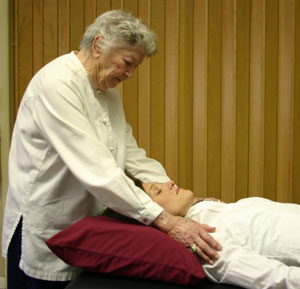One warm spring afternoon, a woman enters a small room overlooking the garden courtyard of Trinity Episcopal Church in Iowa City. With a sigh she removes her headscarf and lies down on the massage table near the window. “It’s been a hard week,” she says. “But three more weeks and I’m done with chemotherapy.”
 A healing touch session at church. Photo: Bob Sessions
A healing touch session at church. Photo: Bob Sessions
As music softly plays on the stereo, I gently place my hands on her feet as we begin our weekly Healing Touch session. For the next 45 minutes, I visualize divine blessings flowing into her, as I practice the ancient form of healing known as laying-on-of-hands.
I end our session by anointing the woman’s head with frankincense and saying a blessing. Afterwards she slowly opens her eyes. “There’s nowhere else in my life where I can experience this kind of deep relaxation and peace,” she says. “Thank you—I feel like myself again.”
Once again, I am amazed by the sense of quiet grace that blesses these Healing Touch sessions in our church.
My participation in this ministry is the fruit of many years of interest in healing, particularly in the growing research on the mind/body connection and the ways in which spirituality can be a powerful adjunct to conventional medical treatments. So when our church began sponsoring a series of workshops given by the Colorado-based
Healing Touch Spiritual Ministry program in 2003, I was eager to learn more.
In our classes I heard about the ancient healing traditions of Christianity. Healing the sick was a central part of Jesus’ ministry and of the early Christian church. The gospels are full of stories about Jesus healing the sick, and Jesus commanded his followers to go and do likewise. But this emphasis was gradually lost over the centuries as illness became solely the domain of physicians and hospitals.
Healing Touch is a modern version of this time-honored practice. Many traditional cultures have recognized that a gentle touch is soothing to those who are ill. More recently, studies conducted at the University of Miami’s
Touch Research Institute have proven that touch is an essential part of human health. Skin is the human body’s largest organ, containing millions of receptors that send messages through nerve fibers to the brain. A simple touch has been shown to reduce a person’s heart rate, lower blood pressure, and reduce stress levels.
Started by a Nurse, It Became a Ministry
Healing Touch as a form of complementary medicine was developed by a nurse, Janet Mentgen, in 1989, as a way to assist the body’s natural healing process by redirecting and rebalancing its energy fields. During a session, practitioners gently place their hands on or above the person’s fully clothed body. Today an estimated 30,000 nurses use HT techniques in medical settings to reduce tension and anxiety, enhance wound healing, reduce post-surgical pain and use of pain medication, and trigger a sense of relaxation in patients. (The related techniques of
Reiki and
Therapeutic Touch have many similarities to Healing Touch, but feature different training programs and philosophies.)
In the 1990s, HT practitioner Linda Smith took note of the many connections between Healing Touch and Christian healing traditions. In 1997 Smith founded Healing Touch Spiritual Ministry as a way of reclaiming the church’s early commitment to healing.
“As practitioners of Healing Touch, we are instruments through which God’s healing energy flows,” says Smith, author of "Called Into Healing: Reclaiming our Judeo-Christian Legacy of Healing Touch." “We address the physical, emotional, mental, and spiritual dimensions of a person. The word ‘heal’ comes from the Old English word haelen, which means to make whole. Healing involves restoring balance to a person’s mind, body, and soul. An abatement of symptoms may be part of a healing, but healing can occur even if the illness isn’t cured in the physical sense.”
Who's Doing It?
A growing number of churches are involved in a hands-on healing ministry, including Roman Catholic, Lutheran, Congregational, and Episcopal parishes around the nation. Among those who are now doing this healing work are clergy, hospice volunteers, parish nurses, chaplains, and members of prayer teams.
Over the past three years, I’ve seen firsthand how churches can support the healing of their communities in body, mind, and spirit. Illness
can affect every aspect of people’s lives and profoundly wound their spirits. But a healing ministry can reassure people that they are loved and cared for, no matter what happens with the physical course of their disease.While some members of my church were initially skeptical, others were intrigued by the idea of making hands-on healing one of our ministries. Some had already heard of HT or had experienced it in a hospital setting. For instance, the Rev. Barbara Schlachter, the wife of our rector, the Rev. Mel Schlachter, had benefited from it when she underwent treatments for breast cancer.
“With Healing Touch, I found that I went through the chemo without any problems, and my energy was much greater than I had been led to believe it would be,” she says. “It was such a caring thing to do and experience, and I realized that it would be good for me to continue with the treatments even after I was no longer going through radiation or chemo. When we moved to Iowa City and discovered that one of the women in the parish offered it, I was quick to sign up. The next thing I knew I was learning how to do it, too. It has become a great joy to offer this prayerful form of healing of body, mind and spirit to people who are suffering.”
Our ministry team now offers laying-on-of-hands during our Sunday morning services, as well as treatments in our healing room and clinics. There is no charge, though a goodwill donation is welcome, with the money going to support further training for practitioners. Since 2003, the 25 people who are part of our ministry team have given nearly 1,000 treatments to both parishioners and the general public.
Why Do People Try Healing Touch?
Some have chronic ailments such as arthritis and diabetes, while others are undergoing chemotherapy or radiation or are in hospice care. Some simply come seeking relief from stress. While a treatment often brings an easing of physical symptoms, many people say that the emotional and spiritual uplift is its primary benefit.
As a practitioner, I find that giving a treatment is healing to me as well. The wordless connection I experience with my clients is profoundly moving. Giving a treatment allows me to empty myself so that God’s love may flow through me.
I recently learned that the University of Iowa Hospitals and Clinics in Iowa City—one of the nation’s largest teaching hospitals—is the site of two research studies on the potential benefits of Healing Touch for cancer patients. One is funded by the National Center for Complementary and Alternative Medicine at the National Institutes of Health, the other by the National Cancer Institute.
While I look forward to the results of these studies, I can already attest to the results of our Healing Touch work all around us. I see people entering our clinics looking tired and worn, only to emerge with a new sense of peace and strength. I talk to former clients who tell me how much it meant to them to receive these treatments. And I see the quiet miracles of grace that often happen in our small healing room overlooking the blooming tulips and daffodils in the church’s garden.
How to Do a Healing Touch Session
In the first level of Healing Touch Spiritual Ministry training, this laying-on-of-hands exercise is taught:
- Begin by placing your hands gently on the head or shoulders of the person who wishes to be healed. Center your thoughts and pray that this person may receive God’s healing.
- Breathe deeply and visualize divine blessings flowing into the person before you. Fill your heart with love and compassion for them.
- As you pray, you may feel a sense of warmth in your hands. Stay focused on the present moment and let the energy flow through you.
- Hold your hands in place as long as the Spirit directs.
- End with a prayer that the person before you may be blessed and upheld in God’s grace.
 A healing touch session at church. Photo: Bob Sessions
A healing touch session at church. Photo: Bob Sessions




